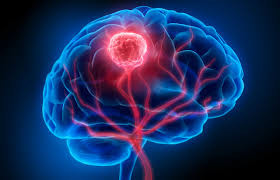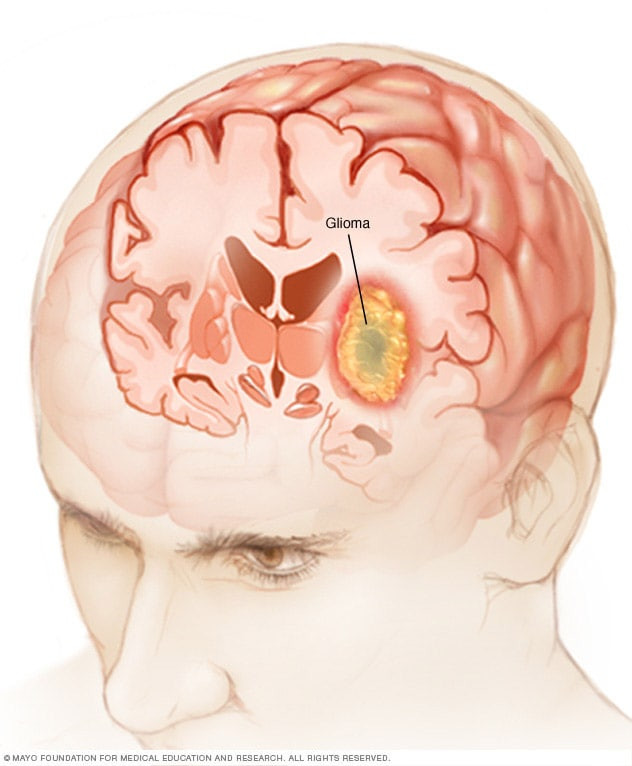Definisi
Space Occupying Lesion (SOL) adalah lesi abnormal yang menempati ruang di otak, biasanya terjadi akibat adanya keganasan, tetapi bisa juga disebabkan oleh kelainan lain seperti abses atau hematoma. Lesi tersebut dapat masuk dan merusak struktur penting otak, menghambat aliran cairan serebrospinal dan menyebabkan hidrosefalus, atau dapat menimbulkan angiogenesis (proses pembentukan pembuluh darah baru) yang akan memecah sawar darah otak, serta menyebabkan edema.
Keganasan pada otak dikategorikan sebagai tumor otak primer dan sekunder. Tumor otak primer adalah tumor otak yang berasal dari pertumbuhan jaringan di dalam otak. Kebanyakan tumor otak primer bersifat jinak. Sementara tumor otak sekunder atau tumor otak metastasis terjadi ketika sel kanker dari jaringan tubuh lain menyebar ke otak, misalnya pada kanker paru-paru dan kanker payudara yang pada stadium lanjut mulai meluas ke organ-organ lain di tubuh.
Penyebab
Penyebab SOL dapat dikelompokkan menjadi:
Keganasan
Contoh keganasan yang bisa menyebabkan SOL adalah metastasis kanker lain ke otak, glioma, meningioma, adenoma pituitary, dan akustik neuroma pada 95% dari seluruh tumor otak. Pada orang dewasa, 2/3 dari tumor otak primer terletak di area supratentorial (berada di atas tentorium, yaitu otak besar), sedangkan pada anak-anak, 2/3 tumor otak terletak di area infratentorial (berada di bawah tentorium, yaitu di otak kecil).
Tumor otak primer seperti astrositoma, glioblastoma multiformis, oligodendroglioma, dan ependimoma ini biasanya tidak mengalami metastasis atau meluas ke organ lain. Tumor yang paling umum bermetastasis ke otak adalah tumor paru-paru, kemudian diikuti tumor payudara, kanker kolon, dan melanoma maligna.
Kista
Kista yang dapat menyebabkan SOL antara lain kista arakhnoid, kista koloid, kista dermoid, dan kista epidermoid.
Hematoma
Penyebab lain dari SOL selain keganasan dan kista adalah hematoma. Hematoma adalah kumpulan darah yang berada di luar pembuluh darah, hal ini bisa terjadi akibat trauma kepala, hidrosefalus, dan abses serebral. Walaupun tidak umum terjadi, abses serebral dapat muncul pada penderita penyakit paru obstruktif kronis (PPOK) yang merupakan sumber infeksi.
Infeksi
Amoebiasis serebral dan sistiserkosis dapat menjadi penyebab SOL walaupun jarang ditemukan. Infeksi HIV, granuloma, dan tuberkuloma juga dapat menyebabkan SOL.
Faktor Risiko
Beberapa faktor yang dapat meningkatkan risiko seseorang menderita SOL adalah faktor-faktor berikut:
- Usia (beberapa jenis tumor otak lebih sering diidap anak-anak)
- Faktor genetik seperti sindrom Gorlin, sindrom Turcot, neurofibromatosis tipe 1 dan 2
- Riwayat trauma kepala
- Riwayat menjalani radioterapi
- Riwayat memiliki penyakit infeksi seperti penyakit paru obstruktif kronis yang dapat memicu terjadinya abses serebral, penyakit TB paru dapat memicu adanya tuberculoma, dll.
- Berat badan berlebih atau obesitas dapat meningkatkan risiko meningioma
Gejala
Beberapa gejala dari tumor otak berbeda-beda tergantung lokasi dimana lesi berada. Otak terbagi menjadi 4 lobus, yaitu lobus temporal, frontal, parietal dan oksipital. Contohnya, bila SOL berada di lobus temporal, dapat memicu gejala depersonalisasi, perubahan emosional, dan gangguan perilaku. Epilepsi lobus temporal dapat menimbulkan gejala halusinasi penciuman, rasa, suara dan penglihatan. Gejala lain seperti penurunan lapang pandang, pelupa, disosiatif fugue, mungkin dapat muncul perilaku seksual yang tidak pantas.
Tumor pada lobus frontal, gejala yang muncul lebih menyebabkan anosmia, perubahan kepribadian (tidak senonoh, tidak bijaksana atau tidak jujur), disfasia, dan hemiparese (kelemahan tubuh sebagian). Tumor yang berada tepat di optic chiasma seperti adenoma pituitary dapat menyebabkan hemianopia bitemporal (kebutaan hanya pada bagian luar kedua mata).
Lesi pada lobus oksipital lebih dominan menimbulkan gejala pada mata. Gejala papilledema atau pembengkakan saraf optik mata dapat terlihat pada saat pemeriksaan oftalmoskop mata. Gejala ini mungkin lebih terlihat pada anak-anak daripada orang dewasa.
Gejala dari adanya SOL dapat berupa sakit kepala. Gejala sakit kepala pada tumor otak cukup klasik, yaitu terasa sangat nyeri saat pagi hari dan memburuk saat menunduk. Ciri khas sakit kepala pada tumor otak berbeda dengan jenis sakit kepala lain seperti tension type headache maupun migrain. Perubahan pola atau frekuensi dari sakit kepala seringkali terjadi pada tumor otak. Sakit kepala lebih sering terjadi pada tumor yang terletak di bagian belakang kepala dan tumor yang bertumbuh dengan cepat.
Muntah juga dapat terjadi dan kadang muncul tanpa disertai mual. Pada SOL, yang terjadi adalah muntah proyektil, akibat adanya peningkatan tekanan dalam otak. Peningkatan tekanan dalam otak, juga dapat memunculkan gejala papilledema selain muntah.
Gejala lain yang juga bisa muncul dapat berupa perubahan status mental, kelemahan, gangguan gaya berjalan (ataksia), defisit bicara, serta kejang seluruh badan. Jika kejang dimulai pada usia paruh baya atau lebih, SOL adalah salah satu kemungkinan diagnosis yang harus dipertimbangkan.
Diagnosis
Untuk menegakkan diagnosis adanya SOL, diperlukan wawancara mendalam (anamnesis) mengenai gejala yang dialami, berapa lama gejala tersebut muncul dan riwayat riwayat pasien. Dokter juga akan melakukan pemeriksaan fisik seputar keluhan yang dialami pasien. Disamping itu, dokter juga akan melakukan pemeriksaan saraf seperti pemeriksaan kekuatan otak, pendengaran atau penglihatan serta saraf wajah. Pemeriksaan penunjang yang dapat dilakukan untuk membantu menegakkan diagnosis dan menyingkirkan diagnosis banding seperti CT scan, PET scan atau MRI.
Tatalaksana
Tatalaksana SOL harus dilakukan sejak dini dengan tujuan untuk mempermudah penanganannya. Apabila tidak segera ditangani, kondisi dapat memburuh seiring berjalannya waktu. Pada kasus keganasan, tumor otak primer biasanya tidak menyebar dan hanya diam di satu tempat saja, tetapi tumor otak bisa memberikan tekanan dan merusak area sekitarnya. Pengobatan tumor otak bergantung dari berbagai hal seperti ukuran, jenis dan lokasi tumor tersebut.
Tatalaksana utama dari tumor otak adalah radioterapi, kemoterapi atau operasi. Terapi radiasi menggunakan sinar berenergi tinggi untuk membunuh sel tumor. Efek samping dari terapi radiasi umumnya berupa rasa lelah, nyeri kepala, penurunan daya ingat, dan iritasi kulit kepala.
Kemoterapi menggunakan obat untuk membunuh sel kanker. Obat kemoterapi dapat diminum atau disuntikkan. Obat kemoterapi yang paling sering digunakan untuk mengatasi tumor otak adalah temozolomide. Efek samping kemoterapi pada umumnya adalah mual, muntah, dan rambut rontok.
Radiosurgery adalah terapi yang melibatkan pancaran sinar radiasi untuk membunuh sel tumor pada area yang kecil. Bila tumor otak memiliki lokasi yang memungkinkan untuk dilakukannya operasi, dokter akan mengangkat bagian tumor sebanyak mungkin. Risiko operasi tumor otak antara lain adalah infeksi dan perdarahan.
Adapun tatalaksana lainnya dapat dilakukan untuk meredakan gejala seperti pemberian obat untuk menurunkan tekanan dalam kepala yang meningkat, obat antikejang, obat antinyeri dan untuk mengatasi gejala mual-muntah.
Komplikasi
Komplikasi yang dapat terjadi akibat SOL berupa penurunan berat badan, nyeri punggung atau nyeri kepala, pembengkakan perut, sulit bernapas, bentuk wajah dan kepala tidak normal, komplikasi tumor otak dapat memburuk dengan cepat dan mengancam nyawa. Tumor otak dapat menimbulkan perdarahan yang memicu peningkatan tekanan dalam otak. Pada beberapa kasus, tumor otak dapat mendesak bagian otak lain terdorong ke tulang belakang karena adanya peningkatan tekanan, hal ini yang disebut dengan herniasi. Tanda herniasi otak berupa napas cepat dan tubuh menjadi kaku. Kondisi ini sangat berbahaya dan mengancam nyawa.
Pencegahan
Anda bisa rutin memeriksakan kesehatan anda secara lengkap ke fasilitas kesehatan terdekat setiap tahunnya sebagai upaya untuk deteksi dini. Selain itu, beberapa cara dapat dilakukan untuk mencegah terjadinya tumor otak juga dengan menerapkan pola hidup sehat, mengurangi atau menghentikan kebiasaan merokok, menghindari paparan sinar radiasi, mengurangi konsumsi makanan berpengawet dan mengandung pemanis buatan.
Kapan harus ke dokter
Disarankan untuk segera ke dokter apabila Anda mengalami gejala seperti yang sudah dijelaskan diatas. Disarankan untuk ke fasilitas kesehatan sedini mungkin sebelum gejala memburuk dan menyebabkan komplikasi, agar Anda mendapatkan penanganan dengan cepat.
- dr Hanifa Rahma
Perkins, A. (2016). Primary Brain Tumors in Adults: Diagnosis and Treatment. Am Fam Physician. 93(3), pp. 211-7.
Owonikoko, et al. (2014). Current Approaches to the Treatment of Metastatic Brain Tumours. Nat Rev Clin Oncol., 11(4), pp. 203–22.
Cancer Research UK (2019). Brain Tumours. Available from: https://www.cancerresearchuk.org/about-cancer/brain-tumours
Mayo Clinic (2018). Diseases and Conditions. Brain Tumor. Available from: https://www.cancerresearchuk.org/about-cancer/brain-tumours












